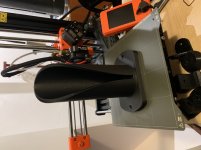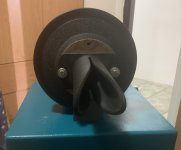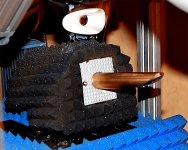Working on my multicell horn and reading of some other K threads lead me back to the idea of trying out a K-Tube on my JBL2445. There are 4 models attached - single and dual slot, each in two lengths. The shorter one is around 1/4 of 500 Hz wavelength and the larger one is maximum size for my QQ-S printer. I will start printing today so that they are ready for the big polar measurement race between multicell, 2380 clone and K-Tubes (scheduled for mid October due to work travel🙁 ).
Attachments
hi pelanj
that's a great looking tube. Carl made what he considered inert tubes using maple veneer laminated around a form and held in place with rubber bands until the glue dried. He apparently tried Karlson's oval tube from the Open End Waveguide patent. (I don't know how he handled the round to oval crossection transition - ?)
For the X15 speaker and two different K-tubes, Karlson used a parabolic slot.
My first K-tubes were paper and cardboard. For no gain that cardboard tube and 4" speaker made a lot of noise with no back chamber.
I used to have on the internet, a comparison of a 6" diameter K-tube vs a tractrix horn, both with Alpha 6A. The horn had more low end. I'm not sure about dispersion as did not take off axis measurements or listen. Both the 5 inch pvc tube and 4 inch cardboard tube came to a point as they had exponential slots vs ellipse or parabolic expansion.
FWIW my feelings on getting wide horizontal dispersion at high F are to use a cone driver in a shallow K cavity (maybe a mini klam??)
- but that pretty much limits sensitivity for tweeter sized cones to the 90s (no problem if sufficient in output and biamped). For midrange, cone speakers which do 100dB are usable.
I've made crude 2" tubes before but had no 2" format drivers. A 3 inch fullrange such as 3fe22 might be fun to excite (hint hint pelanj 😀)
some pix (I don't want to walk over Reinout's thread by showing them)
https://i.imgur.com/c5lTDQu.jpg
https://i.imgur.com/nU4fr4P.jpg
https://i.imgur.com/cNkM39g.jpg
https://i.imgur.com/TwELdwo.jpg
https://i.imgur.com/tY9QsI6.jpg
https://i.imgur.com/bkDGviH.jpg
I
that's a great looking tube. Carl made what he considered inert tubes using maple veneer laminated around a form and held in place with rubber bands until the glue dried. He apparently tried Karlson's oval tube from the Open End Waveguide patent. (I don't know how he handled the round to oval crossection transition - ?)
For the X15 speaker and two different K-tubes, Karlson used a parabolic slot.
My first K-tubes were paper and cardboard. For no gain that cardboard tube and 4" speaker made a lot of noise with no back chamber.
I used to have on the internet, a comparison of a 6" diameter K-tube vs a tractrix horn, both with Alpha 6A. The horn had more low end. I'm not sure about dispersion as did not take off axis measurements or listen. Both the 5 inch pvc tube and 4 inch cardboard tube came to a point as they had exponential slots vs ellipse or parabolic expansion.
FWIW my feelings on getting wide horizontal dispersion at high F are to use a cone driver in a shallow K cavity (maybe a mini klam??)
- but that pretty much limits sensitivity for tweeter sized cones to the 90s (no problem if sufficient in output and biamped). For midrange, cone speakers which do 100dB are usable.
I've made crude 2" tubes before but had no 2" format drivers. A 3 inch fullrange such as 3fe22 might be fun to excite (hint hint pelanj 😀)
some pix (I don't want to walk over Reinout's thread by showing them)
https://i.imgur.com/c5lTDQu.jpg
https://i.imgur.com/nU4fr4P.jpg
https://i.imgur.com/cNkM39g.jpg
https://i.imgur.com/TwELdwo.jpg
https://i.imgur.com/tY9QsI6.jpg
https://i.imgur.com/bkDGviH.jpg
I
Last edited:
Any of my box-like klams with the 3FE22s suffered from resonance problems. Either due to plastic construction or incorrect shape. With the exception of placing the aperture directly in front of the driver, that improved the dispersion. I am not sure why is that.
The tube construction shows potential immediately and almost any shape I tried was good. I mighy actually try a 110 Hz round tube by scaling this one up again - I really like the MDD style speaker, so a K-tube could work for a 2-3 way as a front load for the 3FE22.
The tube construction shows potential immediately and almost any shape I tried was good. I mighy actually try a 110 Hz round tube by scaling this one up again - I really like the MDD style speaker, so a K-tube could work for a 2-3 way as a front load for the 3FE22.
I got an idea. A K-Tube could be very easily integrated into the Tumbling Dice horn: (new adventures in) ultra‑fi: tumbling dice: experimenter’s lower-mid horns
It would just be plugged in from the bottom.
It would just be plugged in from the bottom.
I had a few minutes for a quick mono only test. First impressions - it works, sort of🙂 The FR starts to drop below ca 1100 Hz. It needs to be pointed at the listener, otherwise the high end is reduced. I cannot much comment on the sound other than it is OK.
I would like to get lower loading on the driver, which means a longer tube.

I would like to get lower loading on the driver, which means a longer tube.
AH - the double slotted tube ! = interesting the way the slots are oriented ("top" & "bottom") - I'm using a 9.5" single slot tube.
What can you do for that woofer to make a really compact but impactful sounding rig ?
What can you do for that woofer to make a really compact but impactful sounding rig ?
Yes, higher loading to play lower. I will try to print a longer tube, both single and dual slot.
Curious how long it needs to be to play from 500hz or 700hz for that evdh1a you got there is there a formula you don't mind sharing for 1in and 2in compression drivers about the length needed for specific frequencies
The driver is JBL2445 and the tube should be at least 1/4 of the lowest wavelength. I think since it is dual slotted, the effective lenght is shorter. All the tubes I have made are based on exponential slot expansion and are scaled from the first 1" model.
Sorry it looks like it from that angle because I got a pair of evdh1a and that's how they look and thanks going to read up on that I figured there was a formula for it but go to start reading thanks again
A longer (12.5") single slot tube...does load a bit lower lower. This picture shows a bare driver (blue) vs with tube (black) on axis. In room, 1/12 smoothed.
The ragged low end is most probably due to the in room measurement, but maybe also due to pipe resonances. With EQ, 600 Hz would be the lower cutoff. The interesting feature is that the HF is actually elevated on axis and it would make the JBL2445 play up to 20 kHz in a very narrow sweet spot. Not sure if that had any practical use. The dual slot tube is being printed, but I do not think it would be much different. I think this will be the last K-Tube experiment for now, since I can get much better results with horns and direct radiators. I could see some potential use for tubes above say 2 - 3 kHz as a relatively narrow tweeter - it might actually work really well as an ambience tweeter, making the reflections more random.

The ragged low end is most probably due to the in room measurement, but maybe also due to pipe resonances. With EQ, 600 Hz would be the lower cutoff. The interesting feature is that the HF is actually elevated on axis and it would make the JBL2445 play up to 20 kHz in a very narrow sweet spot. Not sure if that had any practical use. The dual slot tube is being printed, but I do not think it would be much different. I think this will be the last K-Tube experiment for now, since I can get much better results with horns and direct radiators. I could see some potential use for tubes above say 2 - 3 kHz as a relatively narrow tweeter - it might actually work really well as an ambience tweeter, making the reflections more random.
- Home
- Loudspeakers
- Multi-Way
- 3D printed K-Tube for 2" compression drivers


